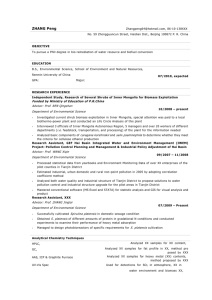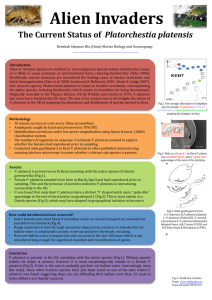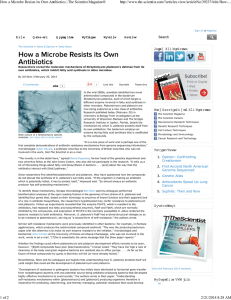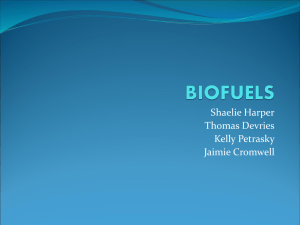Current Research Journal of Biological Sciences 6(1): 53-59, 2014
advertisement
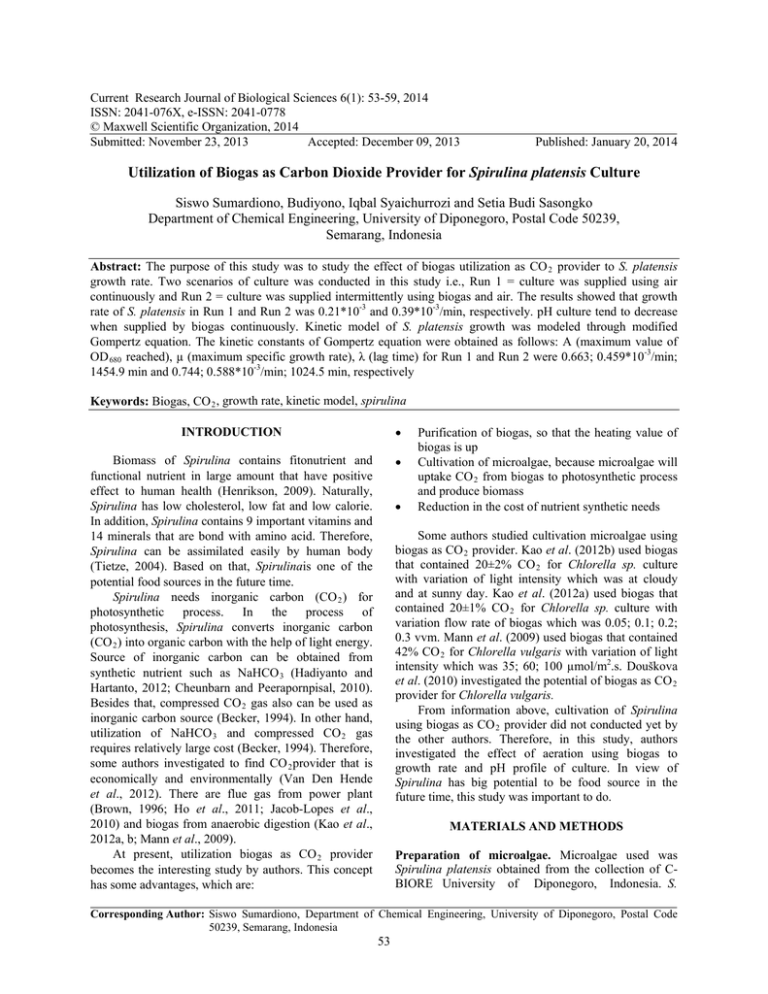
Current Research Journal of Biological Sciences 6(1): 53-59, 2014 ISSN: 2041-076X, e-ISSN: 2041-0778 © Maxwell Scientific Organization, 2014 Submitted: November 23, 2013 Accepted: December 09, 2013 Published: January 20, 2014 Utilization of Biogas as Carbon Dioxide Provider for Spirulina platensis Culture Siswo Sumardiono, Budiyono, Iqbal Syaichurrozi and Setia Budi Sasongko Department of Chemical Engineering, University of Diponegoro, Postal Code 50239, Semarang, Indonesia Abstract: The purpose of this study was to study the effect of biogas utilization as CO 2 provider to S. platensis growth rate. Two scenarios of culture was conducted in this study i.e., Run 1 = culture was supplied using air continuously and Run 2 = culture was supplied intermittently using biogas and air. The results showed that growth rate of S. platensis in Run 1 and Run 2 was 0.21*10-3 and 0.39*10-3/min, respectively. pH culture tend to decrease when supplied by biogas continuously. Kinetic model of S. platensis growth was modeled through modified Gompertz equation. The kinetic constants of Gompertz equation were obtained as follows: A (maximum value of OD 680 reached), µ (maximum specific growth rate), λ (lag time) for Run 1 and Run 2 were 0.663; 0.459*10-3/min; 1454.9 min and 0.744; 0.588*10-3/min; 1024.5 min, respectively Keywords: Biogas, CO 2 , growth rate, kinetic model, spirulina INTRODUCTION • Biomass of Spirulina contains fitonutrient and functional nutrient in large amount that have positive effect to human health (Henrikson, 2009). Naturally, Spirulina has low cholesterol, low fat and low calorie. In addition, Spirulina contains 9 important vitamins and 14 minerals that are bond with amino acid. Therefore, Spirulina can be assimilated easily by human body (Tietze, 2004). Based on that, Spirulinais one of the potential food sources in the future time. Spirulina needs inorganic carbon (CO 2 ) for photosynthetic process. In the process of photosynthesis, Spirulina converts inorganic carbon (CO 2 ) into organic carbon with the help of light energy. Source of inorganic carbon can be obtained from synthetic nutrient such as NaHCO 3 (Hadiyanto and Hartanto, 2012; Cheunbarn and Peerapornpisal, 2010). Besides that, compressed CO 2 gas also can be used as inorganic carbon source (Becker, 1994). In other hand, utilization of NaHCO 3 and compressed CO 2 gas requires relatively large cost (Becker, 1994). Therefore, some authors investigated to find CO 2 provider that is economically and environmentally (Van Den Hende et al., 2012). There are flue gas from power plant (Brown, 1996; Ho et al., 2011; Jacob-Lopes et al., 2010) and biogas from anaerobic digestion (Kao et al., 2012a, b; Mann et al., 2009). At present, utilization biogas as CO 2 provider becomes the interesting study by authors. This concept has some advantages, which are: • • Purification of biogas, so that the heating value of biogas is up Cultivation of microalgae, because microalgae will uptake CO 2 from biogas to photosynthetic process and produce biomass Reduction in the cost of nutrient synthetic needs Some authors studied cultivation microalgae using biogas as CO 2 provider. Kao et al. (2012b) used biogas that contained 20±2% CO 2 for Chlorella sp. culture with variation of light intensity which was at cloudy and at sunny day. Kao et al. (2012a) used biogas that contained 20±1% CO 2 for Chlorella sp. culture with variation flow rate of biogas which was 0.05; 0.1; 0.2; 0.3 vvm. Mann et al. (2009) used biogas that contained 42% CO 2 for Chlorella vulgaris with variation of light intensity which was 35; 60; 100 µmol/m2.s. Douškova et al. (2010) investigated the potential of biogas as CO 2 provider for Chlorella vulgaris. From information above, cultivation of Spirulina using biogas as CO 2 provider did not conducted yet by the other authors. Therefore, in this study, authors investigated the effect of aeration using biogas to growth rate and pH profile of culture. In view of Spirulina has big potential to be food source in the future time, this study was important to do. MATERIALS AND METHODS Preparation of microalgae. Microalgae used was Spirulina platensis obtained from the collection of CBIORE University of Diponegoro, Indonesia. S. Corresponding Author: Siswo Sumardiono, Department of Chemical Engineering, University of Diponegoro, Postal Code 50239, Semarang, Indonesia 53 Curr. Res. J. Biol. Sci., 6(1): 53-59, 2014 Fig. 1: Experimental set up of cultivation S. platensis Table 1: Composition of biogas Component CH 4 CO 2 CO The others Then culture was aerated using air for 6 h. OD 680 and pH of culture were measurement each 60 and 20 min, respectively. Authors also did cultivation of S. platensis with aeration using air as comparison. Detail of experimental design can be seen in Table 2. Value (%) 42.37 48.97 1.92 6.74 platensis was cultivated on medium that was developed by Hadiyanto and Hartanto (2012) with nutrients: 1 g/L NaHCO 3 (purity 98%), 0.05 g/L urea (46% N content), 10 ppm TSP (45% P 2 O 5 content). Cultivation was done in room temperature. Artificial light as light source was obtained from tube light (TL) lamp 18 watt placed with distance of 10-15 cm from culture. Initial pH culture was adjusted 9.0 using HCl 1 M or NaOH 1 M. After cultivation 5-6 days, culture of S. platensis had OD 680 value of 0.5~0.6. This culture condition was used to this study which was investigation of biogas utilization as CO 2 provider. Experimental procedures. Optical density of all variables was measured two times by using spectrophotometry UV-VIS at λ 680 nm each 60 min. Value of pH culture was measured by using pH meter each 20 min. The results of investigation were used to calculate the growth rate, growth curve and pH profile curve: µ = ln (𝑂𝑂𝑂𝑂i−𝑂𝑂𝑂𝑂0)/(𝑡𝑡i−𝑡𝑡0) where, µ, = Growth rate (/day) OD i = Optical density at t i OD 0 = Optical density at t 0 = Cultivated time i ti, = Cultivated time 0. t0, Preparation of biogas: This study used biogas that produced from vinasse using anaerobic digestion. Based on ours previous study, the composition of biogas can be seen in Table 1. Kinetic model of S. platensis growth: Many authors studied about growth of microalgae, but they did not model it. Zwietering et al. (1990) stated that predictive modeling of microorganism growth allowed the prediction of shelf life of products, the detection of critical parts of the production, the optimization of production. Zwietering et al. (1990) proposed the modified Gompertz equation to make model of microorganism growth, which is written as: Experimental set up: Culture of S. platensis that had OD 680 ~0.6 putinto bubble column photo-bioreactor (PBR). PBR was designed with height of 64 cm and diameter of 4 cm. Material used to design PBR was acrylic polymer. Biogas was supplied from bottom of PBR with flow rate 100 mL/min. Artificial light as light source was obtained from Tube Light (TL) lamp 18 watt placed with distance of 10-15 from PBR. Experimental set up of this study can be seen in Fig. 1. µ. 𝑒𝑒 (𝜆𝜆 − 𝑡𝑡) + 1�� 𝐴𝐴 𝑦𝑦 = 𝐴𝐴. 𝑒𝑒𝑒𝑒𝑒𝑒. �− exp � Experimental design: In this study, biogas was supplied for 4 h into culture. Optical Density (OD) of biomass was measured using spectrophotometry UVVIS (SP-300) at wave length 680 nm each 60 min and pH culture was measured using pH meter each 20 min. Authors modeled growth of S. platensis using modified Gompertz equation above, with kinetic constant: 54 Curr. Res. J. Biol. Sci., 6(1): 53-59, 2014 Table 2: Experimental design Run Aeration Cultivation time Response 1 Air 10 h OD 680 and pH of culture were measurement each 60 and 20 min, respectively 2 Biogas-Air 4h-6h Remarks: OD 680 , Optical density at wave length 680 nm; h, hours y A µ λ e = = = = = • OD 680 at any time Maximum value of OD 680 reached Maximum specific growth rate (/minute) Lag time (minutes) Mathematical constant (2.718282) Effect of biogas aeration to growth of S. platensis and pH culture: Comparison of S. platensis growth curve between on culture aerated using air and medium aerated using biogas can be seen in Fig. 2 and 3. Growth of S. platensis increased quickly at first 120 min and then decreased at second 120 min aeration using biogas (Fig. 3). The quickly growth at beginning cultivation was caused by availability of CO 2 that was in large amount in culture. However, continuous supplying of biogas that was rich CO 2 caused drop in pH culture. Carbon dioxide was reacted with water (H 2 O) to form H 2 CO 3 (Carbonate acid). In culture, H 2 CO 3 was dissociated into HCO 3 - and H+. Accumulation of H+ ion caused pH culture drop. Meanwhile, HCO 3 - was changed by S. platensis with help carbonic anhydrase enzyme into CO 2 and OH-. Carbon dioxide formed was used as inorganic carbon source for photosynthetic process and ion OH- was released by S. platensis through cell membrane. Accumulation of OH- caused alkalinity in pH culture (De-Morais and Costa, 2007). In this study, Production of H 2 CO 3 or H+ was more quickly than production OH, so that pH culture had decreasing trend of pH profile (Fig. 4). Liu et al. (2008) reported that pH affected the enzymatic activity and electron transport activity of microalgae in the photosynthetic and respiration process, therefore decreasing in pH hampered the growth of S. platensis. According to Yang and Gao (2003), culture that contained too much carbon dioxide was toxic for microalgae. Maximum concentration of CO 2 in gas feed was permitted was 5%v/v. Carbon was main element of microalgae. Content of carbon in microalga was in range 36-58% (Sydney et al., 2010). Carbon dioxide was main carbon source that was needed by microalgae for photosynthetic process, but presence of CO 2 had negative effects when it was too much in culture, which were: • Disturbing the photosystem II efficiency (Xu et al., 2004). That phenomenon occurred at second 120 min of aeration using biogas. Decreasing of OD 680 value of culture indicated that an amount of S. platensis was death. S. platensis grew well in range pH of 8-11 Richmond (1988) and Tadros (1988) insisted that concentration of S. platensis cell was increasing when pH culture increasing from 8 to 10, then was decreasing when pH culture out of the range. In this study, pH culture was decreasing at first 20 min of cultivation, which pH drop from 9.6 to 7, then pH culture was constant (7-7.1) until at 240th min (Fig. 4). This phenomenon showed that pH culture out of range 8-11 caused S. platensis growth inhibition. Kao et al. (2012b) stated that pH culture was decreasing as long as 30 min when culture was aerated by using biogas. The lower pH condition of culture, the more dissolved inorganic carbon was in culture. Dissolved inorganic carbon that was too much in culture had toxic characteristic for microalgae. RESULTS AND DISCUSSION • Result Effect of difference of aeration composition to OD 680 and pH of culture Effect of cycle-switching operation to growth of S. platensis and pH culture: After culture had aerated by using biogas for 240 min, culture aerated by using air until at 600th min (Fig. 3). During cultivation, growth of S. platensis and pH culture was increasing gradually (Fig. 3 and 4). This phenomenon was caused by photosynthetic activity, which CO 2 that was dissolved in the culture was utilized by microalgae as carbon source (Kao et al., 2012a, b). Kao et al. (2012b) reported that cycle-switching operation, which culture was aerated by using biogasair simultaneously, affected stable on up-taking of CO 2 by microalgae so microalgae grew well. Cycleswitching operation affected trend of pH culture, which pH culture was being fluctuation during cultivation. pH culture was decreasing when biogas was used as aerator and pH culture was increasing when air was used as aerator (Chiu et al., 2011). This result showed the same phenomenon that was reported by the other authors (Kao et al., 2012b; Chiu et al., 2011) and insisted that cycle-switching operation was better than continuously aeration using biogas or air to grow S. platensis (Fig. 2 and 3). S. platensis had tolerance to CO 2 concentration in range 10-15% (Sydney et al., 2010; Kumar et al., 2010), that means S. platensis could grow well in culture that contained CO 2 concentration in that range. Whereas, in this study, biogas used contained high concentration of CO 2 which was 48.97% sogrowth of S. Platensis was hampered when biogas was supplied Decreasing the biomass productivity (Watanabe et al., 1992) Decreasing the pH culture (Falkowski and Raven, 2007) 55 Curr. Res. J. Biol. Sci., 6(1): 53-59, 2014 0.7 0.68 aerated OD 680 0.66 0.64 0.62 0.6 0.58 0.56 air experiment 0.54 0 60 120 180 240 300 360 Time (minute) 420 480 540 600 Fig. 2: Growth curve of S. platensis in medium aerated using air 0.7 0.68 OD 680 0.66 aerated using aerated using air 0.64 0.62 0.6 0.58 0.56 cycle-switching experiment 0.54 0 60 120 180 240 300 360 420 480 540 600 Time (minute) Fig. 3: Growth curve of S. platensis in medium aerated using biogas-air (cycle-switching operation) aerated using air 12 10 pH 8 6 aerated using air aerated using 4 air experiment 2 cycle-switching operation 0 0 60 120 180 240 300 360 420 480 540 600 Time (minute) Fig. 4: Profile of pH continuously into culture. The same results also was reported by Kao et al. (2012b), biogas that contained 20±2% CO 2 caused decreasing trend in pH culture and decreasing % CO 2 removal from minute to minute during cultivation. However, the different results was reported by Brown (1996), mutant of Monoraphidiumminutum grew well in culture which was supplied by using flue gas contained 13.6% CO 2 and biomass of that was increasing from minute to minute. In addition, growth of Monoraphidiumminutum in culture that was aerated by flue gas was faster than that in culture that aerated by air. Condition of pH 56 Curr. Res. J. Biol. Sci., 6(1): 53-59, 2014 Table 3: Growth rate of Spirulinaplatensis Run OD 680 max T µ 1 0.6265 600 0.21*10-3 2 0.7 600 0.39*10-3 Remarks: Run I = aerated by using air; Run 2 = aerated by using biogas-air (cycle-switching operation); t, time at OD 680 max; µ, maximum specific growth rate (/minute) Gompertz equation was obtained the graph as shown in Fig. 5. From Table 3, the kinetic constant A value of Run 2 was higher than Run 1, that means value OD 680 of Run 2 in prediction was more than Run 1. Culture that contained carbon dioxide in appropriate amount was good for microalgae because microalga could do photosynthetic activity to produce biomass (Watanabe et al., 1992). However, concentration of carbon dioxide was excess (moreover 10-15%) in culture, it was toxic for S. platensis (Sydney et al., 2010; Kumar et al., 2010). By use of cycle-switching operation (Run 2), concentration dissolved CO 2 in culture could be controlled in other to be not excess, so S. platensis activity was not disturbed and also was not lack of carbon dioxide. Run 2 had kinetic constant of µ that was higher than Run 1, that means growth rate of S. platensis in culture of Run 2 was faster than that of Run 1. Culture of Run 1, availability of inorganic carbon was decreasing during cultivation and supplying of carbon dioxide source was not done, so that S. platensis did not do photosynthetic and finally death. Meanwhile S. platensis in Run 2 could do photosynthesis continuously because supplying of carbon dioxide was done periodically (cycle-switching operation). culture was stable during cultivation. Based on that, we could conclude that each kind of microalgae had the difference of tolerance maximum CO 2 concentration. Growth rate of S. platensis in culture that was aerated by using air and by using biogas-air (cycleswitching operation) can be seen in Table 3. At cycleswitching operation, S. platensis could grow well and utilized dissolved CO 2 as inorganic carbon to produce biomass so that growth rate of S. platensis in culture of Run 2 was faster than that in cultureof Run 1. Growth rate (µ) on Run 1 and Run 2 were 0.21*10-3 and 0.39*10-3/min, respectively. Kinetic model of S. platensis growth: Growth of S. platensis was modeled through modified Gompertz equation. Kinetic constant of y, µ and λ was determined by using non-linear regression. Kinetic constants obtained were presented completely in Table 4. By plotting experiment data and simulation of modified Table 4: Kinetic constant of S. platensis growth Run A µ 1 0.663 0.459*10-3 2 0.744 0.588*10-3 λ -1454.9 -1024.5 Model 0.459 ∗ 10−3 . 𝑒𝑒 ((−1454.9) − 𝑡𝑡) + 1�� 𝑦𝑦 = 0.663 ∗ 𝑒𝑒𝑒𝑒𝑒𝑒 �− exp � 0.663 𝑦𝑦 = 0.744 ∗ 𝑒𝑒𝑒𝑒𝑒𝑒 �− exp � 0.588 ∗ 10−3 . 𝑒𝑒 ((−1024.5) − 𝑡𝑡) + 1�� 0.744 R2 0.978 0.795 Remarks: Run I = aerated using air; Run 2 = aerated using biogas-air (cycle-switching operation); A, maximum value of OD 680 reached; µ, maximum specific growth rate (/minute); λ, lag time (minutes); R2, correlation coefficient (a) (b) Fig. 5: Comparison of experimental data and modified Gomperz model, (a) in culture aerated by using air, (b) in culture aerated by using cycle-switching operation 57 Curr. Res. J. Biol. Sci., 6(1): 53-59, 2014 CONCLUSION Hadiyanto, M.M.A. and G.D. Hartanto, 2012. Enhancement of biomass production from spirulinasp cultivated in POME medium. Proceeding of International Conference on Chemical and Material Engineering, ISBN: 978602-097-281-7. Henrikson, R., 2009. Earth Food Spirulina. Ronore Enterprises Inc., Hawaii, USA. Ho, S.H., C.Y. Chen, D.J. Lee and J.S. Chang, 2011. Perspectives on microalgal CO2-emission mitigation systems: A review. Biotechnol. Adv., 29: 189-198. Jacob-Lopes, E., C.G.H. Scoparo, M.I. Queiroz and T.T. Franco, 2010. Biotransformations of carbon dioxide in photobioreactors. Energ. Convers. Manage., 51: 894-900. Kao, C.Y., S.Y. Chiu, T.T. Huang, L. Dai, L.K. Hsu and C.S. Lin, 2012a. Ability of a mutant strain of the microalga Chlorella sp. to capture carbon dioxide for biogas upgrading. Appl. Energ., 98: 176-183. Kao, C.Y., S.Y. Chiu, T.T. Huang, L. Dai, G.H. Wang, C.P. Tseng, C.H. Chen and C.S. Lin, 2012b. A mutant strain of microalga Chlorella sp. for the carbon dioxide capture from biogas. Biomass Bioenerg., 36: 132-140. Kumar, A., X. Yuan, A.K. Sahu, S.J. Ergas, H. Van Langenhove and J. Dewulf, 2010. A hollow fiber membrane photo-bioreactor for CO2 sequestration from combustion gas coupled with wastewater treatment: A process engineering approach. J. Chem. Technol. Biot., 85: 387-394. Liu, Y.H., R. Ruan, Q.X. Kong, C.M. Liu, J. Luo and F. Yu, 2008. Mass culture of high oil content microalgae on wastewater and power plant flue gases. Chin. J. Bioprocess. Eng., 6: 29-33. Mann, G., M. Schlegel, R. Schumann and A. Sakalauskas, 2009. Biogas-conditioning with microalgae. Agron. Res., 7: 33-38. Richmond, A., 1988. Spirulina. In: Borowitzka, M.A. and L.J. Borowitzka (Eds.), Micro-agal Biotechnology. Cambridge University Press, Cambridge. Sydney, E.B., W. Sturm, J.C. De Carvalho, V. ThomazSoccol, C. Larroche, A. Pandey and C.R. Soccol, 2010. Potential carbon dioxide fixation by industrially important microalgae. Bioresource Technol., 101: 5892-5896. Tadros, M.G., 1988. Characterization of Spirulina Biomass for CELSS Diet Potential. NASA Contractor NCC 2-501. Tietze, H.W., 2004. Spirulina Micro Food Macro Blessing. 4th Edn., Haralz W Tietze Publishing, Australia. Van Den Hende, S., H. Vervaeren and N. Boon, 2012. Flue gas compounds and microalgae: (Bio-) chemical interactions leading to biotechnological opportunities. Biotechnol. Adv., 20: 1405-1424. Biogas could be used as carbon dioxide provider. In this study, biogas used contained 42.37% CH 4 ; 48.97% CO 2 ; 1.92% CO and other gases. S. platensis could not grow well in culture that was aerated by using biogas continuously. Condition of pH in culture that was aerated by using biogas had decreasing trend so that S. platensis was disturbed by this condition. Cycleswitching operation gave the satisfied growth of S. platensis which was 0.39*10-3/min. Whereas growth rate of S. platensis in culture that was aerated by using air continuously was 0.21*10-3/min. Kinetic model of S. platensis in culture aerated using by air had kinetic constant of A = 0.663; µ = 0.459*10-3/min; λ = -1454.9 min. Whereas Kinetic model of S. platensis in culture aerated by using cycle-switching operation had kinetic constant of A = 0.744; µ = 0.588*10-3/min; λ = -1024.5 min. ACKNOWLEDGMENT The authors thank to University of Diponegoro and Indonesian Ministry of Higher Education via Hibah Kompetensi 2013 grant for financial support. REFERENCES Becker, E.W., 1994. Microalgae, Biotechnology and Microbiology. Cambridge University Press, Cambridge. Brown, L.M., 1996. Uptake of carbon dioxide from flue gas by microalgae. Energ. Convers. Manage., 37: 1363-1367. Cheunbarn, S. and Y. Peerapornpisal, 2010. Cultivation of Spirulina platensis using anaerobically swine wastewater treatment effluent. Int. J. Agric. Biol., 12: 586-590. Chiu, S.Y., C.Y. Kao, T.T. Huang, C.J. Lin, S.C. Ong and C.D. Chen, 2011. Microalgal biomass production and on-site bioremediation of carbon dioxide, nitrogen oxide and sulfur dioxide from flue gas using Chlorella sp. cultures. Bioresource Technol., 102: 9135-9142. De-Morais, M.G. and J.A.V. Costa, 2007. Biofixation of carbon dioxide by Spirulina sp. and Scenedesmusobliquus cultivated in a three-stage serial tubular photobioreactor. J. Biotechnol., 129: 439-445. Douškova, I., F. Kaštanek, Y. Maleterova, P. Kaštanek, J. Doucha and V. Zachleder, 2010. Utilization of distillery stillage for energy generation and concurrent production of valuable microalgal biomass in the sequence: Biogas-cogenerationmicroalgae-products. Energ. Convers. Manage., 51: 606-611. Falkowski, P.G. and J.A. Raven, 2007. Aquatic Photosynthesis. Princeton University Press, Princeton. 58 Curr. Res. J. Biol. Sci., 6(1): 53-59, 2014 Watanabe, Y., N. Ohmura and H. Saiki, 1992. Isolation and determination of cultural characteristics of microalgae which functions under CO2 enriched atmosphere. Energ. Convers. Manage., 33: 545-552. Xu, M., S. Chen, G. Liu and Z. Hu, 2004. Pilot study of physiological and morphological acclimation of Scenedesmusarmatus under extreme-high CO2stress. J. Wuhan Bot. Res., 22: 439-444. Yang, Y. and K. Gao, 2003. Effects of CO2 concentrations on the freshwater microalgae Chlamydomonas reinhardtii, Chlorella pyrenoidosa and Scenedesmus obliquus (Chlorophyta). J. Appl. Phycol., 15: 379-389. Zwietering, M.H., I. Jongenburger, F.M. Rombouts and K. Van’triet, 1990. Modelling the bacterial growth curve. Appl. Environ. Microb., 56: 1875-1881. 59
